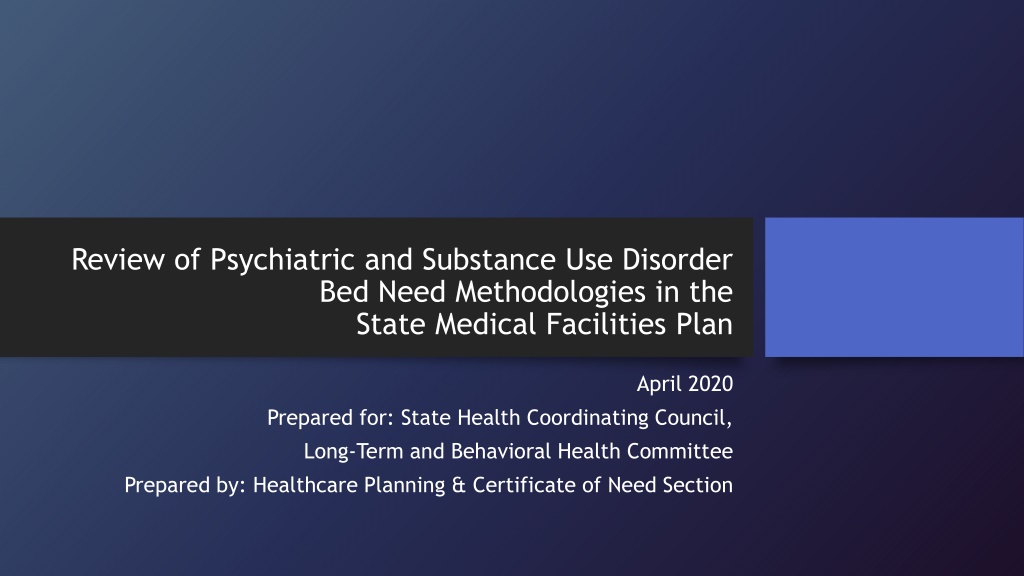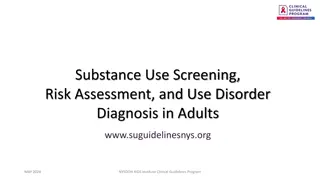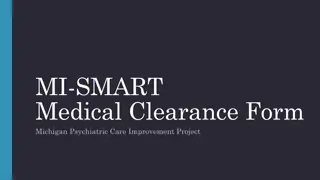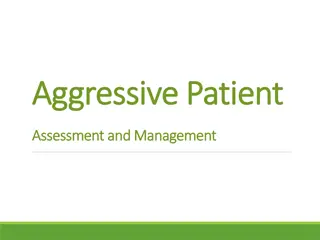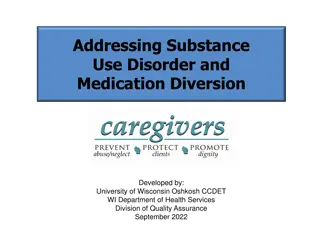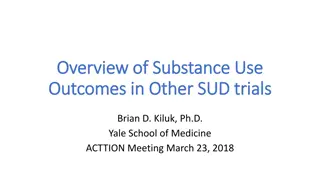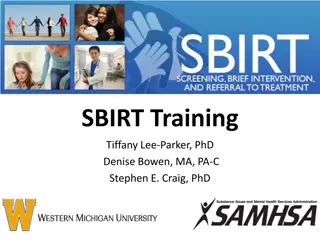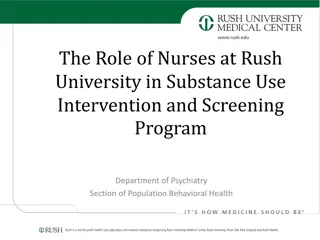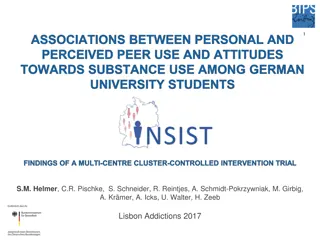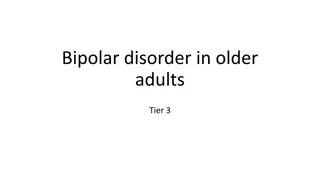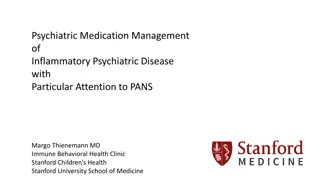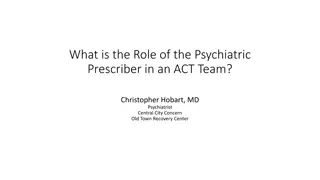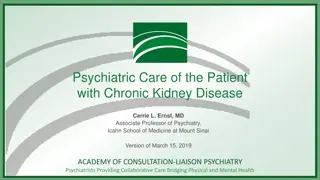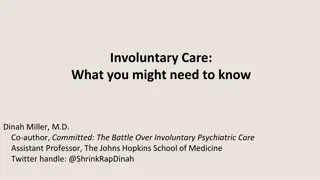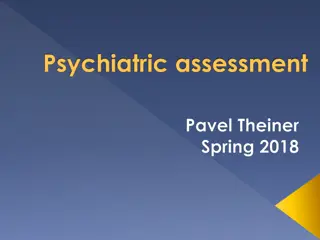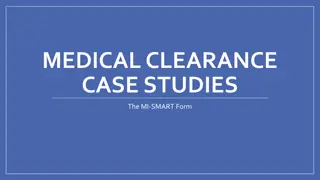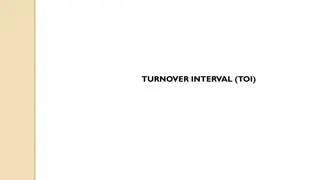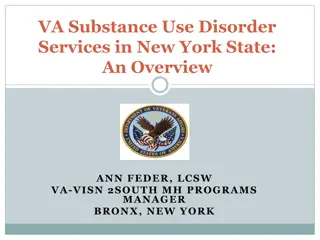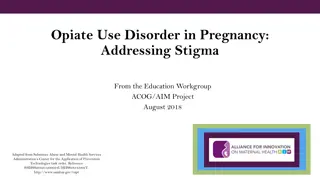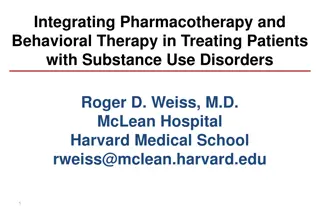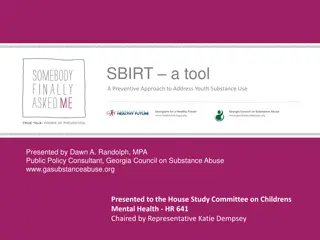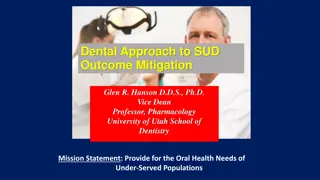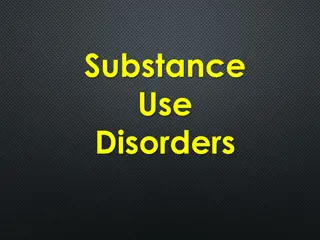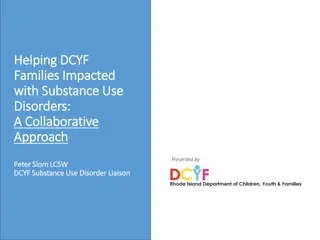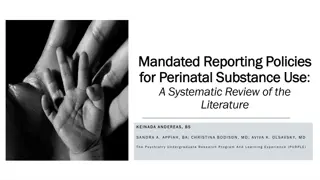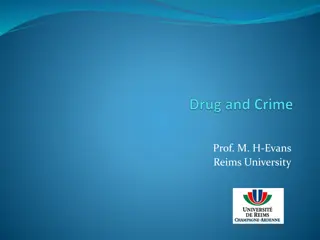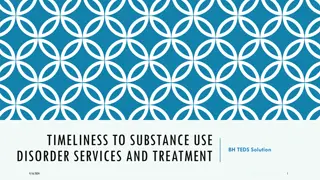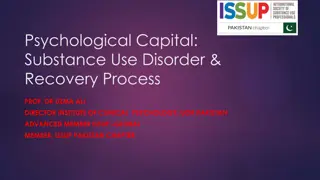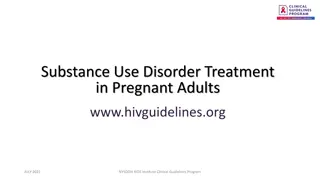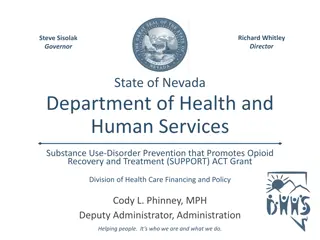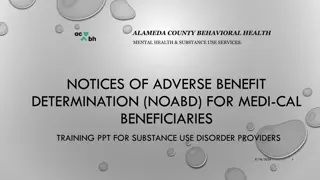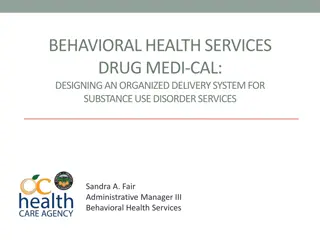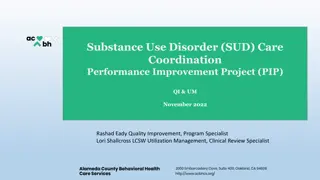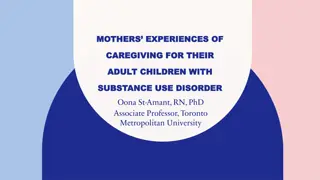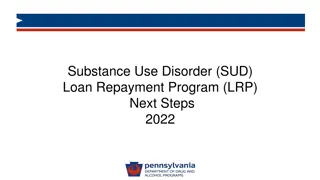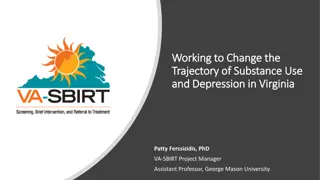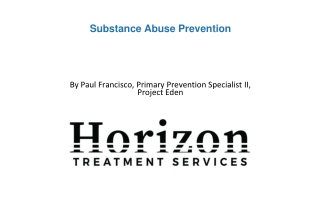Review of Psychiatric and Substance Use Disorder Bed Need Methodologies
The report discusses the methodologies for determining the need for psychiatric and substance use disorder beds in the State Medical Facilities Plan, addressing the disconnect between existing methodology and the perceived need for additional beds. It explores principles, assumptions, calculations, and alternatives to the current methodology to better meet the demand for mental health services. The State Medical Facilities Plan primarily covers licensure categories subject to Certificate of Need law, focusing on adult and child/adolescent beds. Opportunities for applying for additional beds through CON or petitions to the SHCC are outlined.
Download Presentation

Please find below an Image/Link to download the presentation.
The content on the website is provided AS IS for your information and personal use only. It may not be sold, licensed, or shared on other websites without obtaining consent from the author. Download presentation by click this link. If you encounter any issues during the download, it is possible that the publisher has removed the file from their server.
E N D
Presentation Transcript
Review of Psychiatric and Substance Use Disorder Bed Need Methodologies in the State Medical Facilities Plan April 2020 Prepared for: State Health Coordinating Council, Long-Term and Behavioral Health Committee Prepared by: Healthcare Planning & Certificate of Need Section
Healthcare Planning invites SHCC members and members of the public to submit comments on this annotated presentation. Email any comments you wish to make to DHSR.SMFP.Petitions-Comments@dhhs.nc.gov . Deadline for Comments: May 6, 2020 Healthcare Planning will post all comments on our website and present them to the LTBH committee for consideration at the May 14, 2020 meeting. If you have specific questions not addressed in the presentation, please contact Amy Craddock (amy.craddock@dhhs.nc.gov).
Reasons for Current Examination of Methodology Need methodology does not often show need for additional adult beds, but many mental health professionals and others are certain that more beds are needed What can SMFP and CON law/process do to address this disconnect? It s time to examine Principles and assumptions on which the methodology is based Methodology calculations Alternatives if current methodology is not adequate
The State Medical Facilities Plan Covers beds only in licensure categories that are subject to the Certificate of Need law Private psychiatric hospitals Psychiatric units in acute care hospitals SMFP does not cover Other facilities/beds that provide residential behavioral health treatment/services (e.g., crisis centers) Hospital emergency departments State facilities NC residents who receive treatment out of state Out of-state residents who receive treatment in NC (account for about 4-5% of total adult days of care) Proportion of total licensed beds covered in SMFP Adult 89% Child/adolescent 23% Produces need determinations for adult and child/adolescent beds by LME-MCO People can apply for CON to develop beds anywhere in any LME-MCO that shows a need Cannot develop more beds than need determination indicates Petitions People can petition the SHCC to develop beds based on characteristics of specific geographic area or population
Need Determinations and CON Applications, 2015-2020, Psychiatric Inpatient Beds Adult Beds Child/Adolescent Beds Need Determinations 46 35 106 47 48 89 SMFP Need Beds Applied for Beds Applied for Determinations 69 36 40 0 0 2 2015 2016 2017 2018 2019 2020 63 32 25 --- --- 0 0 0 0 0 * * * All CON due dates have not yet passed for the 2020 SMFP
Number of Current and Planned Beds Child/Adolescent, 2018 386 licensed (2020 SMFP) 0 CON-approved under development 10 additional from last PSY-1 transfers Adult, 2018 1,977 licensed (2020 SMFP) 95 CON-approved under development Approximately 257 others 124 - last group of SMFP Policy PSY-1 transfers ~133 sale of Dorothea Dix Hospital property/GA funds Within ? years, about 2,329
Does NC Need Additional Inpatient Psychiatric Beds? Overall utilization of inpatient psychiatric beds in NC, 2018 data from SMFP Adults 62% Children/Adolescents 86% In 2017, NC ranked 35th on combined measure of prevalence of mental illness and access to all types of care (rank of 1 is best). Adults 21st Youth 44th (age 12-17) 2012 study in NC, estimated need for 356 additional inpatient beds to reduce wait ED times to 1 day.
Adult Child/ Adolescent LME-MCO Beds per Capita 26 25 28 31 17 23 21 24 Beds per Capita 20 20 0 12 12 25 9 17 Beds Population Beds Population Alliance Cardinal Eastpointe Partners Sandhills Trillium Vaya TOTAL 1,448,897 2,447,435 508,482 797,236 866,230 1,157,232 860,718 8,086,230 92 465,592 714,486 154,729 216,925 257,507 314,045 192,446 2,315,730 382 613 143 250 146 263 180 140 0 27 30 80 17 1,977 386 Table 1. Bed Availability Per Capita by LME-MCO
Current Methodology Service (catchment) area is LME-MCO Area for which needs are projected 75% is optimum occupancy to achieve before methodology calculates a need for additional beds Calculations project need 4 years beyond the reporting year Data reported for 2018 is projected to 2022 ( projection year ) Planning inventory Licensed beds in psychiatric hospitals and in units of acute care hospitals CON-approved beds not yet licensed Includes licensed beds that may not be operational/staffed Days of care (DOC) by patient s LME-MCO of residence is basis for utilization Separate methodologies for adults and children/adolescents, but calculations are the same
Calculations Calculate DOC for reporting year DOC in licensed beds in psychiatric facilities/units DOC in standard beds in acute care hospitals Not multi-day stays in EDs Calculate DOC for projection year Multiply DOC by projection year population Divide by reporting year population Calculate number of beds needed for projection year Divide DOC for projection year by 75% Calculate need determination Subtract number of beds needed for projection year from number of beds in planning inventory
Considerations in Assessing Current Methodology Principles and assumptions Bed availability in relation to population Bed utilization Patient migration out of home LME-MCO
Principles and Assumptions of the Methodology Assumptions Patients should be able to get services near their LME-MCO of residence. 75% is optimum occupancy Project needs 4 years beyond reporting year to allow for time to develop new beds Principles Inpatient beds provide more than stabilization but less than long-term institutionalization (less than 60 days). Admission to community-based facility is preferable to admission to state facility for people in acute distress. Continuum of services should be provided. Separate units for of adult and child/adolescent patients.
Adult Child/Adolescent LME-MCO % Total Utilization 67% 71% 36% 58% 50% 71% 49% 62% % Total Utilization 132% 80% Beds Beds 92 382 613 143 250 146 263 180 Alliance Cardinal Eastpointe Partners Sandhills Trillium Vaya Total 140 0 0% 17% 50% 83% 80% 86% 27 30 80 17 1,977 386 Table 2. Facility Bed Utilization by LME-MCO, 2018
General Options to Current Methodology 1. Use same calculations as current methodology, but change the service area. use patient county of residence as basis for calculating utilization and need Interpretation: Need determination reflects the need for beds to serve people who are residents of each service area 2. Change the basis for calculating need use location of the facility as basis for calculating utilization and need Interpretation: Need determination reflects the need for beds in each service area, based on the utilization of facilities in the service area 3. Eliminate the mathematically-based need methodology 4. Status Quo - Do nothing
Option 1: Change the Service Area Use same calculations as current methodology, but Change the Service Area Still use patient county of residence. We considered three optional service area configurations as basis for need projections 1. Patient s Health Service Area (HSA) of residence DHSR uses 6 geographically-defined HSAs (see next slide) Unlike LME-MCO, made up of contiguous counties 2. Patient s Substance Use Disorder methodology region of residence 3 regions based on LME-MCOs Western Partners, Vaya Central Alliance, Cardinal, Sandhills Eastern Eastpointe, Trillium 3. Statewide service area Calculate need for state as a whole
Option 2: Change Basis for Calculating Utilization Used same calculations as current methodology Changed BASIS FOR CALCULATING DAYS OF CARE Days of care in each facility Used Same Service Areas as Option 1 LME-MCO of facility (used in current methodology) Health Service Areas (HSA) of facility Substance Use Disorder methodology region of facility Statewide
Option 3: Eliminate Mathematically-Based Need Methodology Possible Rationales The SMFP includes less than 25% of child/adolescent beds Includes all licensed beds, but 18% of beds in acute care hospitals are not operational Agency has no data to address social determinants of need for treatment or services provided, primarily ability to pay Methodology excludes out-of-state residents who receive treatment in NC Could apply to all facilities or only to child/adolescent or adult SMFP does not require mathematically-based need methodology, but development of inpatient beds requires CON Currently, CON application must project 75% utilization by end of second operating year This requirement can change SMFP can set some requirements/thresholds/parameters regarding development of beds as long as they do not conflict with CON law (or other laws)
Option 4: Status Quo If, after consideration, the Committee finds that the current methodology is the best option, then the committee needs to take no action.
Table 3. Summary of Need Determinations for Mathematically-based Methodology Options 2020 SMFP Change Service Area Change Basis for Need Projections Bed Type LME- MCO LME- MCO HSA SUD State HSA SUD State Child/ Adolescent 89 96 64 63 97 94 86 66 Adult 2 52 0* 0* 22 16 0** 0*** Total 91 148 64 63 119 110 86 66 * ** Surplus of 414 beds *** Surplus of 250 beds Surplus of 274 beds
Substance Use Disorder Inpatient/Residential Bed Need Methodology
Background Methodology implemented in 1984 SMFP only a couple of minor tweaks since then SMFP includes only inpatient and residential beds that are covered in the CON law, which comprise about 35% of all adult substance use disorder (SUD) beds in the state about 2% of child/adolescent SUD beds in the state SMFP does not cover Group homes Therapeutic communities State facilities Detention/correctional facilities
Utilization Statewide utilization 73% adults 21% children/adolescents About 24% of days of care are provided in acute care hospitals Probably stays of less than 7 days Only about 38% of the SUD beds in acute care hospitals are operational.
Methodology Bed need determinations are calculated separately for children/adolescents and for adults Produces bed need determinations by 3 LME-MCO-based planning regions Western Partners, Vaya Central Alliance, Cardinal, Sandhills Eastern Eastpointe, Trillium Based on days of care for patients by their region of residence Methodology calculates total need and then assigns needed beds to children/adolescents that are sufficient to provide 9% of the total days of care projected (for adults children/adolescents combined)
Need Determinations and CON Applications, 2015-2020, Substance Use Disorder Beds Adult Beds Child/Adolescent Beds Need Determinations 28 28 17 15 20 23 SMFP Need Beds Applied for Beds Applied for Determinations 37 45 0 14 34 33 * All CON due dates have not yet passed for the 2020 SMFP 2015 2016 2017 2018 2019 2020 12 22 --- 14 0 0 8 0 0 * 0 * Why aren t beds in SMFP applied for? $$$$$ A single need determination of just a few beds may not be efficient
Proposal Eliminate SMFP s mathematically-based methodology, but continue to report inventory and utilization Allow development of beds anywhere Currently, CON applications must show that applicant can meet performance standards: Existing facilities must show in the 9 months preceding CON application: 1-15 beds 75% utilization 16+ - 85% utilization Proposed new facilities must show that by end of 2nd operating year 1-15 beds 75% utilization 16+ - 85% utilization Policy MH-1 in the SMFP requires CON applicants to invite the LME-MCO to comment on the proposed service
Summary and Next Steps This annotated presentation has explained the rationale for examining the behavioral health bed methodologies in the SMFP and offered some options to the current methodologies. Next Steps: email any comments you wish to make to DHSR.SMFP.Petitions-Comments@dhhs.nc.gov . Deadline for Comments: May 6, 2020 Healthcare Planning will post all comments on our website and make them available to the LTBH committee for consideration at the May 14, 2020 meeting. At that meeting, the LTBH committee may choose to make recommendations to the SHCC regarding these methodolgies.
